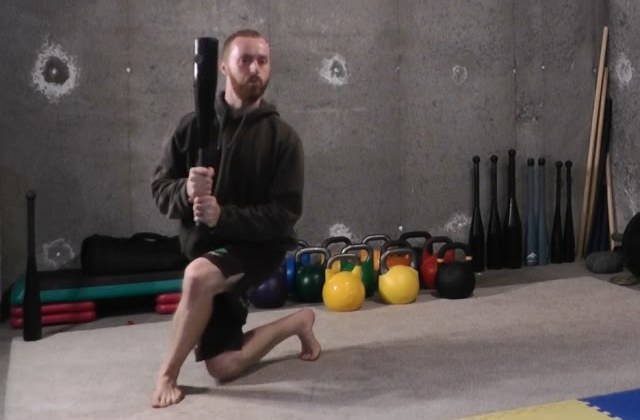Below, you’ll see a video from a semi-recent strength training session I did using clubbells to strengthen hip flexion/extension, internal/external rotation, and abduction/adduction. Basically, the whole kit and kaboodle to strengthen all of the musculature surrounding the hip joints (e.g. hip flexors, glutes, quads, and hamstrings).
Now, whether you call it strengthening a variety of positions, hitting the muscles from different angles, training different functional patterns, or strengthening muscles through movement using 3D/6DOF training, good movement is good movement. And you’ll get better results if you try to strengthen your muscles throughout their full range of motion in a variety of ways.
But John, everyone knows that clubs are for grip strength and shoulder mobility. But legs…really?
O ye of little faith. Have a look-see.
Training Hips & Legs With Clubbells
If you want the technical details, here’s what I did…
1st Clubbell Exercise Circuit
Double Clubbell Swing/Clean to Order Position with Alternating Forward and Reverse Lunges (e.g. forward lunge with right leg, reverse lunge with right leg, forward lunge with left leg, reverse lunge with left leg).
2nd Clubbell Exercise Circuit
Two-handed Clubbell Side Pendulum to Order Position with Alternating Lateral Lunges and Modified Plié Lunges – using a Side Rock-it in between transitions from side to side.
Clubbell Workout Protocol
I went through each circuit three times:
1st circuit: 50% of maximum effort (i.e. the warmup round, until I was halfway “smoked”)
2nd circuit: 75% of maximum effort (i.e. the round of escalating intensity, but saving some for later)
3rd circuit: 100% of maximum effort (i.e. to technical failure)
Key Points
- The clubbell is a full-body tool – not just for the grip, arms, and shoulders, as many folks incorrectly assume. And contrary to popular belief, you can absolutely train your legs quite effectively with clubs.
- You’ll get more well-rounded and balanced strength and muscle development from training a variety of movement patterns than from specializing in one or two.
- Combining exercises into circuits and/or complexes is a great use of sophistication for progression.
- Not only are the muscles of the hips and legs challenged in multiple planes from this combination, but the core musculature is as well since it has to stabilize the spine (and the clubbell!) in multiple ways.
- Even though these complexes may appear complicated, it is merely a refinement of the basics. With enough practice of the basics, performing complexes like these becomes accessible – even second nature – as your practice grows. And it should go without saying that you should master each exercise of a complex before using it in a complex.
Note: I’ve been using clubbells for over ten years, and plan to continue using them for the foreseeable future because they are a great tool. You can learn more about how clubbells can help you here: The Complete Clubbell Review.
If you found this article helpful, please share it with your friends:
.jpg)
![]()
Health-First Fitness Coach
P.S. If you liked this post, then please signup for the newsletter, or follow me on Facebook or Twitter for daily updates and other interesting info.
